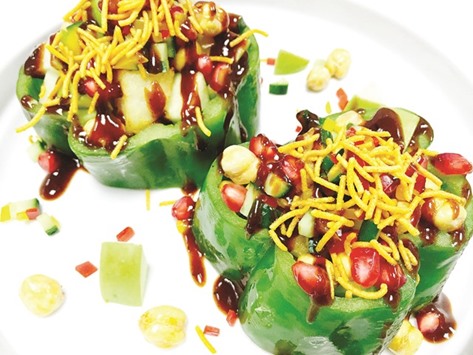It is very hard to ignore the presence of the crunchy, colourful, tangy and sweet capsicum or bell peppers in our daily diet. Some people call it capsicum, others call it bell peppers or just peppers — whatever you may prefer to say, it remains one of the most favourite vegetables in the world.
One very common question that people often ask me is the difference between capsicum and bell peppers. Actually there is not much difference apart from the capsaicin content. Bell peppers don’t have any significant capsaicin content as compared to capsicum. Christopher Columbus is credited with coining the name “pepper”. The name “pepper” was mainly used in Europe for all species of plants that were hot and later it was extended to the new capsicum family.
Capsicum belongs to the flowering plant family named Solanaceae. It is native to America where it has been cultivated for many years. In countries like India, Australia, New Zealand it is known as capsicum, In United Kingdom and Europe it is called red pepper, green pepper or chilli pepper. In USA and Canada the large sized capsicum is called bell pepper. Technically it is fruit, but is widely categorised as vegetable.
Available in vivid colours of green, red, yellow, orange, purple, brown and black, this beautiful vegetable is an eye candy and is attractive with its vibrant colours. It is a member of the nightshade family, which includes potatoes, tomatoes and eggplant. The primary substance that controls the “hotness” in peppers is called capsaicin and it is found in small quantities in capsicum or bell peppers and that’s the reason they are not hot as compared to chilli, which is rich in capsaicin.
The name bell peppers also relates to its bell shape, featuring either three or four lobes. The green and purple peppers have a slightly bitter flavour, while the red, orange and yellow are sweeter and almost fruity. Green peppers are less sweet and slightly bitterer than yellow or orange peppers, with red bell peppers being the sweetest. The taste of ripe peppers can also vary with growing conditions and post-harvest storage treatment; the sweetest fruits are allowed to ripen fully on the plant in full sunshine, while fruit harvested green and after-ripened in storage is less sweet.
Paprika is one popular spice prepared from capsicum. The fruit of chilli pepper family of capsicum annum is air dried and powdered to get paprika. Paprika as a spice is more associated with Hungarian cuisine. Bell peppers are available throughout the year but taste delicious during summer.
Although bell peppers are very popular and widely consumed, they have not always been considered or associated with health, maybe due to their minimal capsaicin content. Once active in the body, capsaicin can bind to nerve cell receptors and change pain sensation and it may also have important anti-cancer and blood sugar balancing properties. However the lack of a significant amount of capsaicin in bell peppers does not mean that this popular vegetable should be anyway ignored in our diet.
Bell peppers lack capsaicin because of this recessive gene that washes out this chemical — that’s why pepper don’t give the burning sensation experienced from capsicum. Capsicum and peppers also used for their medicinal properties, in analgesics and circulatory stimulants. Another recent use of this vegetable is in aerosol called pepper spray or capsicum spray used to incapacitating people in a non-lethal way and also as a means of self-defence.
Another impressive nutritional property of the bell pepper is its low fat. There is less than 1 gram of fat in a cup of diced bell peppers — which makes it an ideal diet ingredient and low fat ingredient for your calorie-specific recipes. Bell peppers are also a good source of Vitamin E and also contain carotenoids and these have anti-inflammatory and anti-oxidants health benefits.
Capsicum and Indian Cuisine
Capsicum is an active ingredient in Indian cuisine and blends well with the exotic aromatic spices and adds it’s crunchy and colourful character to the dish. The below recipes is for a Indian chaat prepared using the capsicum and other related ingredients.
Capsicum Chana Chaat
Ingredients (serves 2)
Capsicum 2 no
Olive oil 1 tbsp
Chickpeas 100 gm
Potato 100 gm
Cucumber 1 no
Tomato 1 no
Pomegranate 50 gm
Potato straw 50 gm
Coriander leaves 3 tbsp
Man leaves, chopped 3 tbsp
Chat Masala ½ tsp
Salt to taste
Yoghurt 4 tbsp
Method
Cut the capsicums into half and remove their heads and bottoms to get four hollow capsicum cylinders.
Rub the bell pepper cylinders with olive oil and grill them on hot plate to give grill marks but still keeping the capsicum crunchy, remove and keep aside.
Boil the potato till 3/4th cooked and cut into ½ inch dices and deep fry to make them crispy and golden brown in colour; keep aside.
Also boil the chick peas till they are soft, keep aside.
Cut the cucumber and tomato into small dices and place in a salad bowl.
Add the fried potato and boiled chickpeas and sprinkle chat masala, salt and coriander and mint leaves.
Toss all the ingredients to combine well, adjust the seasoning.
Place the grilled capsicum cylinders in a serving plate and fill with the prepared salad.
Drizzle with whisked yoghurt, sprinkle fried potato straw and pomegranate seeds on top, serve warm.
* Chef Tarun Kapoor,
Culinary Mastermind, USA. He may be contacted at [email protected]

Capsicum Chana Chaat. Photo by the author


